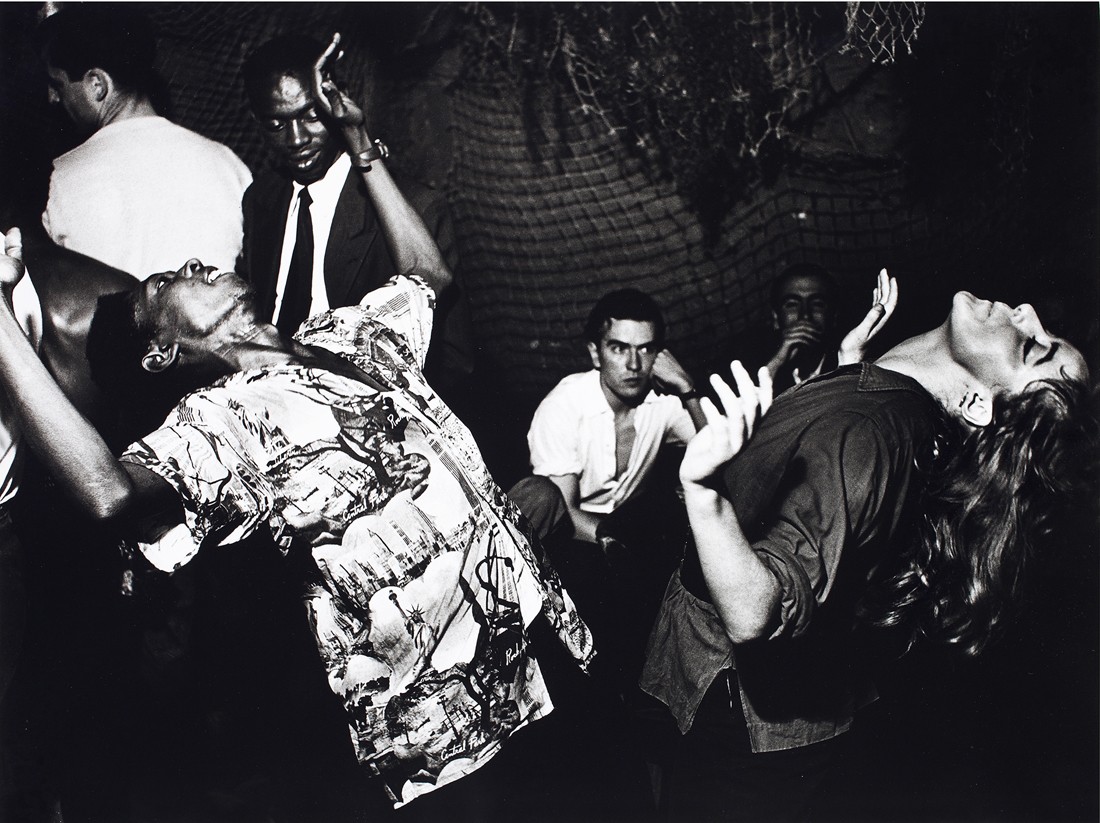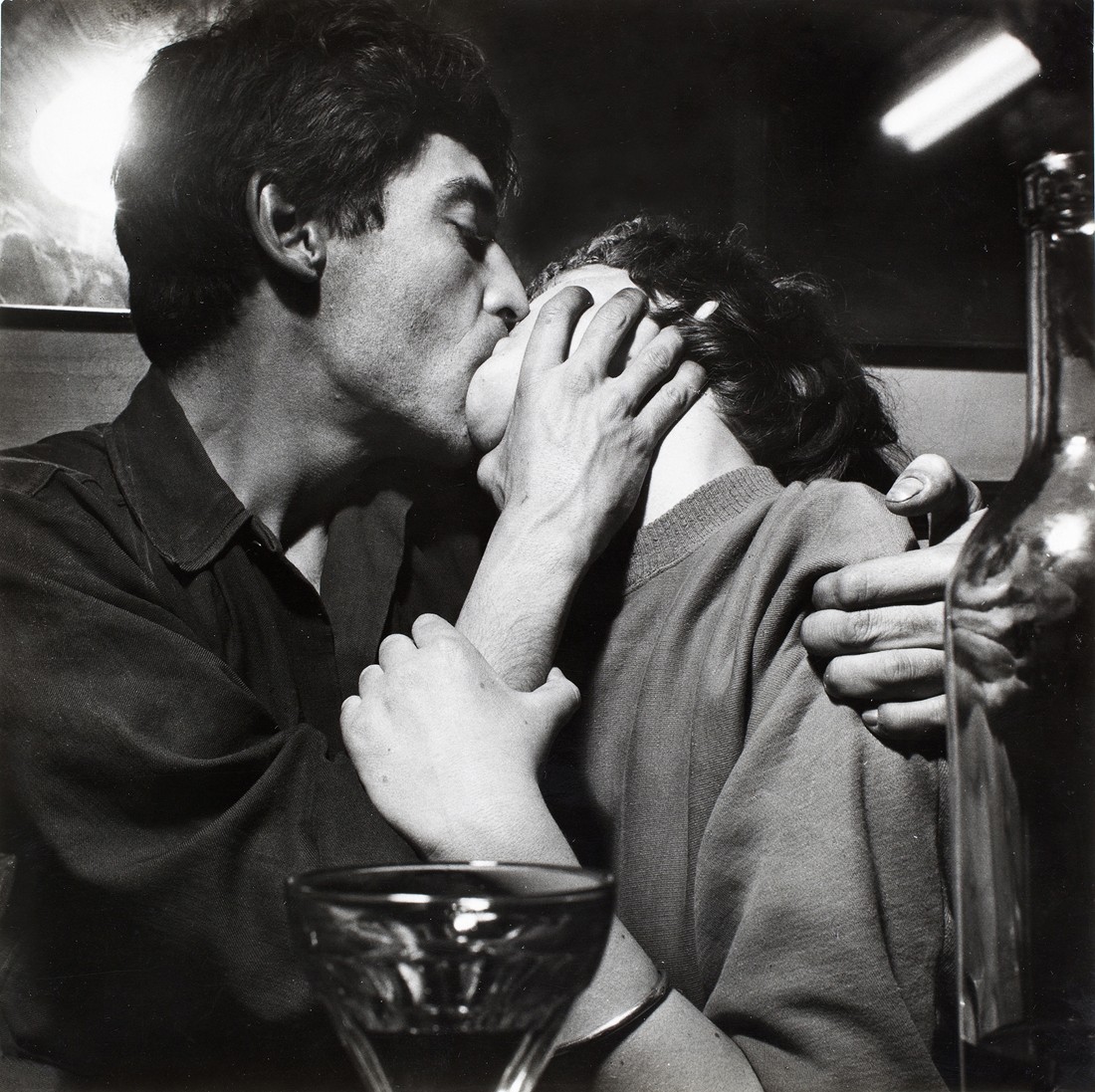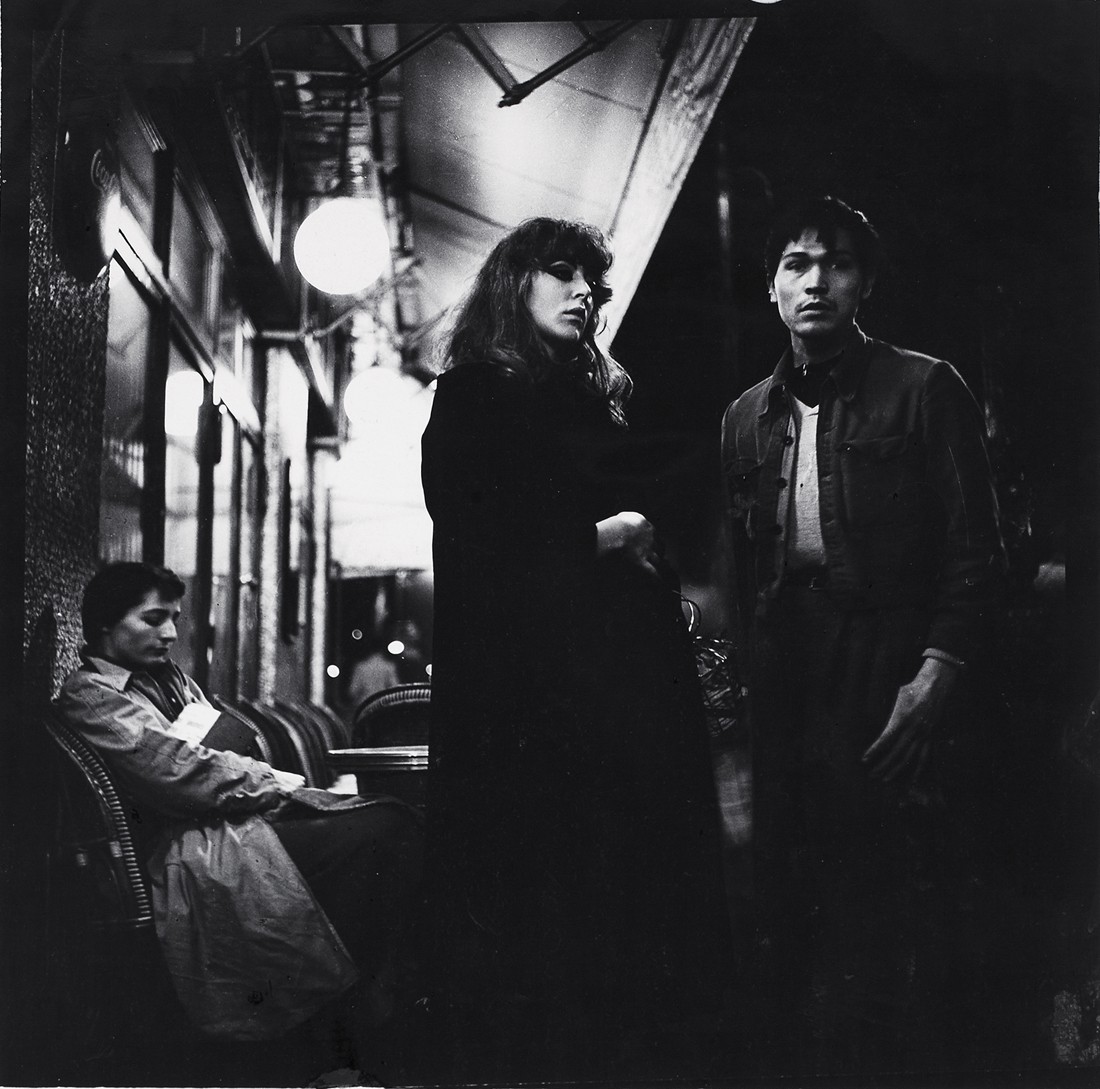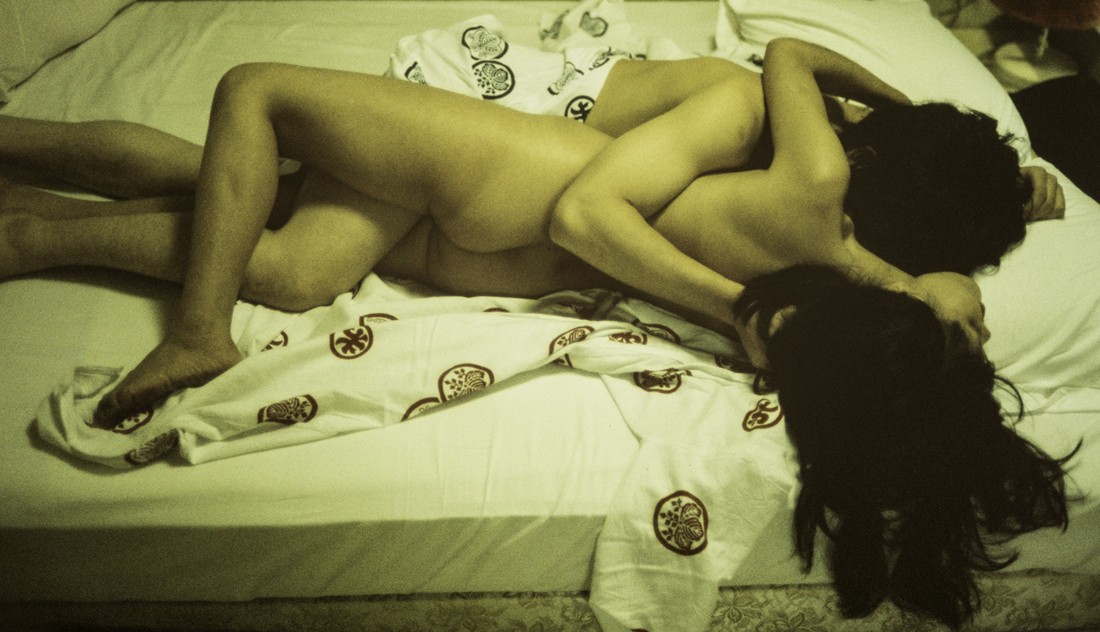Ed van der Elsken
Camera in Love
13 Jun - 24 Sep 2017

Vali Myers (Ann) danse à La Scala
Paris, 1950
Ed van der Elsken
Nederlands Fotomuseum Rotterdam. © Ed van der Elsken / Collection Stedelijk Museum Amsterdam
Paris, 1950
Ed van der Elsken
Nederlands Fotomuseum Rotterdam. © Ed van der Elsken / Collection Stedelijk Museum Amsterdam

Pierre Feuillette (Jean-Michel) et Paulette Vielhomme (Claudine) s’embrassant au afé Chez Moineau, Rue du Four
Paris, 1953
Ed van der Elsken
Nederlands Fotomuseum Rotterdam. © Ed van der Elsken / Collection Stedelijk Museum Amsterdam
Paris, 1953
Ed van der Elsken
Nederlands Fotomuseum Rotterdam. © Ed van der Elsken / Collection Stedelijk Museum Amsterdam

Vali Myers (Ann), Roberto Inigez-Morelosy (Manuel) et Géraldine Krongold (Geri)
Paris, 1950
Ed van der Elsken
Nederlands Fotomuseum Rotterdam. © Ed van der Elsken / Collection Stedelijk Museum Amsterdam
Paris, 1950
Ed van der Elsken
Nederlands Fotomuseum Rotterdam. © Ed van der Elsken / Collection Stedelijk Museum Amsterdam

Brigitte Bardot
Paris, 1952 (v. 1979)
Ed van der Elsken
Nederlands Fotomuseum Rotterdam. © Ed van der Elsken / Ed van der Elsken Estate
Paris, 1952 (v. 1979)
Ed van der Elsken
Nederlands Fotomuseum Rotterdam. © Ed van der Elsken / Ed van der Elsken Estate

Beethovenstraat
Amsterdam, 1967
Ed van der Elsken
Nederlands Fotomuseum Rotterdam. © Ed van der Elsken / Ed van der Elsken Estate, courtesy Annet Gelink Gallery
Amsterdam, 1967
Ed van der Elsken
Nederlands Fotomuseum Rotterdam. © Ed van der Elsken / Ed van der Elsken Estate, courtesy Annet Gelink Gallery

Des adolescents au look des années 50 devant leur café favori
Amsterdam, 1983 (v. 1978)
Ed van der Elsken
Nederlands Fotomuseum Rotterdam. © Ed van der Elsken / Ed van der Elsken Estate
Amsterdam, 1983 (v. 1978)
Ed van der Elsken
Nederlands Fotomuseum Rotterdam. © Ed van der Elsken / Ed van der Elsken Estate

Rockers, Harajuku
Tokyo, 1984
Ed van der Elsken
Nederlands Fotomuseum Rotterdam. © Ed van der Elsken / Ed van der Elsken Estate
Tokyo, 1984
Ed van der Elsken
Nederlands Fotomuseum Rotterdam. © Ed van der Elsken / Ed van der Elsken Estate

Fille dans le métro
Tokyo, 1981
Ed van der Elsken
Nederlands Fotomuseum Rotterdam. © Ed van der Elsken / Collection Stedelijk Museum Amsterdam
Tokyo, 1981
Ed van der Elsken
Nederlands Fotomuseum Rotterdam. © Ed van der Elsken / Collection Stedelijk Museum Amsterdam

Couple s’embrassant
Japon, vers 1974 (2015)
Ed van der Elsken
Nederlands Fotomuseum Rotterdam. © Ed van der Elsken / Ed van der Elsken Estate, courtesy Annet Gelink Gallery
Japon, vers 1974 (2015)
Ed van der Elsken
Nederlands Fotomuseum Rotterdam. © Ed van der Elsken / Ed van der Elsken Estate, courtesy Annet Gelink Gallery

Réfugiée
Hong Kong, 1959-1960
Ed van der Elsken
Nederlands Fotomuseum Rotterdam. © Ed van der Elsken / Collections spéciales de l’université de Leyde
Hong Kong, 1959-1960
Ed van der Elsken
Nederlands Fotomuseum Rotterdam. © Ed van der Elsken / Collections spéciales de l’université de Leyde
ED VAN DER ELSKEN
Camera in Love
13 June - 24 September 2017
Curator : Hripsimé Visser
Ed van der Elsken (1925-1990) is a unique figure in Dutch 20th-century documentary cinema and photography. As a photographer, his preferred subject was the street, and in cities like Paris, Amsterdam, Hong Kong or Tokyo, he enjoyed ‘hunting’ for subjects. Often qualified as a "photographer of marginal figures", he sought in reality an aesthetic form, a visual authenticity, devoid of artifice, a beauty that was sometimes openly sensual, at times even erotic. Ed van der Elsken was fascinated by these proud figures, full of life and vitality.
The exhibition at the Jeu de Paume presents a large selection of some of his most iconic images: shots of Paris from the 1950s, figures photographed on his numerous travels or in his native Amsterdam from the 1960s onwards, as well as his books, and excerpts from his films and slide shows, particularly Eye Love You and Tokyo Symphony.
Van der Elsken photographs and films his subjects in situations that are often theatrical, and he behaves like a director, engaging in conversation with the people he photographs. He likes to be provocative and encourages his subjects to exaggerate or accentuate certain personality traits he detects in them. In addition to his theatrical, extravagant photography, Van der Elsken has also produced a large number of understated and moving images, revelatory of his poetic nature, his innate sense of solidarity with others, and his profound empathy for all living creatures.
Van der Elsken published approximately twenty books and produced a large number of films. His first book, Love on the Left Bank, was published in 1956. Taking the form of a banal but rather unusual photobook, Love on the Left Bank is a semi-fictive account of disaffected young people, living in Paris after the Second World War. The dark tone and expressive approach, as well as the book’s almost cinematic quality contributed to its instant success. Love on the Left Bank was followed by a number of photo documentaries from his travels: Bagara (1958) featuring photographs from his trip to Equatorial Africa, and Sweet Life (1966), from his round-the-world journey in 1959-1960.
Jazz (1958) is also worth mentioning. The book is a vibrant ode to the explosion of jazz music on the Amsterdam scene. In the 1980s, he published photobooks on Paris and Amsterdam, as well as De ontdekking van Japan (The Discovery of Japan) based on his numerous trips to Japan, and colour publications: Eye Love You (1976), depicting photographs from around the world against the backdrop of the liberal atmosphere of the 1960s and 70s, and Avonturen op het land (Adventures in the Countryside) (1980), Van der Elsken’s tribute to life in the polders in the northern Netherlands.
For Van der Elsken, photography was never fixed. His work could be used for publications or books, just as easily as it could be screened (if in colour), or shown in slide-show format. His exhibitions often consisted of installations combining prints, texts, and multiple formats. In the 1960s and 1970s, his presentations were far removed from more traditional or conventional photographic exhibitions.
At the same time, the growing market for photography and Van der Elsken’s own financial demands made him more aware of the value of his prints, which he often worked in a very personal and expressive fashion. For his photography work and his films, he always tried to find the technique that suited his approach and the subject, even inventing one himself, if needs be. His pioneering use of colour photography was little recognized at the time, even discredited by his contemporaries. In Paris, as early as the 1950s, he had already been using colour photography, but due to financial and technical constraints, this work was rarely reproduced, or in some cases, not at all.
Excerpts from films and slide shows exhibited as part of the Eye Love You and Tokyo Symphony exhibition were edited after his death using the sound script and his numerous colour shots. In addition to his contact sheets, drawings and maquettes for some of his works, personal documents, letters, and notes shed new light on his way of working and his personality. Excerpts from his texts, often caustic or humorous in tone, complete the presentation of this masterful photographer and film-maker.
The exhibition is organised by the Stedelijk Museum Amsterdam in collaboration with the Jeu de Paume.
With special thanks to Anneke Hilhorst and Han Hogeland, Nederlands Fotomuseum Rotterdam, the Special Collections Department of Leiden University, EYE Film Museum Amsterdam, Netherlands Institute for Sound and Vision, Hilversum, Annet Gelink Gallery Amsterdam and Paradox Edam.
This exhibition is part of Oh ! Pays-Bas, Dutch cultural season in France 2017-2018.
Media partners: À Nous Paris, de l’air, Time Out Paris, Transfuge, Paris Première, France Inter Thanks to the Hôtel Napoléon Paris.
Camera in Love
13 June - 24 September 2017
Curator : Hripsimé Visser
Ed van der Elsken (1925-1990) is a unique figure in Dutch 20th-century documentary cinema and photography. As a photographer, his preferred subject was the street, and in cities like Paris, Amsterdam, Hong Kong or Tokyo, he enjoyed ‘hunting’ for subjects. Often qualified as a "photographer of marginal figures", he sought in reality an aesthetic form, a visual authenticity, devoid of artifice, a beauty that was sometimes openly sensual, at times even erotic. Ed van der Elsken was fascinated by these proud figures, full of life and vitality.
The exhibition at the Jeu de Paume presents a large selection of some of his most iconic images: shots of Paris from the 1950s, figures photographed on his numerous travels or in his native Amsterdam from the 1960s onwards, as well as his books, and excerpts from his films and slide shows, particularly Eye Love You and Tokyo Symphony.
Van der Elsken photographs and films his subjects in situations that are often theatrical, and he behaves like a director, engaging in conversation with the people he photographs. He likes to be provocative and encourages his subjects to exaggerate or accentuate certain personality traits he detects in them. In addition to his theatrical, extravagant photography, Van der Elsken has also produced a large number of understated and moving images, revelatory of his poetic nature, his innate sense of solidarity with others, and his profound empathy for all living creatures.
Van der Elsken published approximately twenty books and produced a large number of films. His first book, Love on the Left Bank, was published in 1956. Taking the form of a banal but rather unusual photobook, Love on the Left Bank is a semi-fictive account of disaffected young people, living in Paris after the Second World War. The dark tone and expressive approach, as well as the book’s almost cinematic quality contributed to its instant success. Love on the Left Bank was followed by a number of photo documentaries from his travels: Bagara (1958) featuring photographs from his trip to Equatorial Africa, and Sweet Life (1966), from his round-the-world journey in 1959-1960.
Jazz (1958) is also worth mentioning. The book is a vibrant ode to the explosion of jazz music on the Amsterdam scene. In the 1980s, he published photobooks on Paris and Amsterdam, as well as De ontdekking van Japan (The Discovery of Japan) based on his numerous trips to Japan, and colour publications: Eye Love You (1976), depicting photographs from around the world against the backdrop of the liberal atmosphere of the 1960s and 70s, and Avonturen op het land (Adventures in the Countryside) (1980), Van der Elsken’s tribute to life in the polders in the northern Netherlands.
For Van der Elsken, photography was never fixed. His work could be used for publications or books, just as easily as it could be screened (if in colour), or shown in slide-show format. His exhibitions often consisted of installations combining prints, texts, and multiple formats. In the 1960s and 1970s, his presentations were far removed from more traditional or conventional photographic exhibitions.
At the same time, the growing market for photography and Van der Elsken’s own financial demands made him more aware of the value of his prints, which he often worked in a very personal and expressive fashion. For his photography work and his films, he always tried to find the technique that suited his approach and the subject, even inventing one himself, if needs be. His pioneering use of colour photography was little recognized at the time, even discredited by his contemporaries. In Paris, as early as the 1950s, he had already been using colour photography, but due to financial and technical constraints, this work was rarely reproduced, or in some cases, not at all.
Excerpts from films and slide shows exhibited as part of the Eye Love You and Tokyo Symphony exhibition were edited after his death using the sound script and his numerous colour shots. In addition to his contact sheets, drawings and maquettes for some of his works, personal documents, letters, and notes shed new light on his way of working and his personality. Excerpts from his texts, often caustic or humorous in tone, complete the presentation of this masterful photographer and film-maker.
The exhibition is organised by the Stedelijk Museum Amsterdam in collaboration with the Jeu de Paume.
With special thanks to Anneke Hilhorst and Han Hogeland, Nederlands Fotomuseum Rotterdam, the Special Collections Department of Leiden University, EYE Film Museum Amsterdam, Netherlands Institute for Sound and Vision, Hilversum, Annet Gelink Gallery Amsterdam and Paradox Edam.
This exhibition is part of Oh ! Pays-Bas, Dutch cultural season in France 2017-2018.
Media partners: À Nous Paris, de l’air, Time Out Paris, Transfuge, Paris Première, France Inter Thanks to the Hôtel Napoléon Paris.
